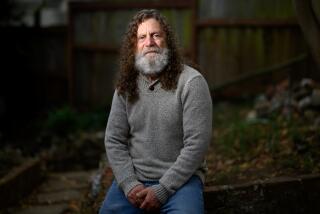Biological clout
- Share via
BESIDES being the ne plus ultra of gadflies, James D. Watson -- the Nobel laureate biologist whose recent impolitic remark about the relative intelligence of Africans and inhabitants of the developed world resulted in his resignation as chancellor of Cold Spring Harbor Laboratory -- is the author of one of the best science books ever written for a general audience: “The Double Helix” (1968), in which he recounts how he and Francis Crick discovered the structure of DNA, the nucleic acid of which genes are made. It is an engaging and accessible portrait of the scientific process, notwithstanding the famous eccentricity of both principals.
Watson was 25 when he did that work. Today he’s just shy of 80, and in “Avoid Boring People” (a beautifully double-barreled title whose punch is pulled by the jacket design), from his near-octogenarian heights, he passes on what he can to young scientists coming up and to the rest of us as well. The chapters of this new memoir -- an earlier one, “Genes, Girls, and Gamow,” was mostly about his pursuit of female company after receiving his Nobel Prize -- each has “Manners” in its title (“Manners Learned While an Undergraduate,” “Manners Noticed as a Dispensable White House Adviser”). It’s a strange word for him to have chosen; manners, except for bad ones, are not what Watson is known for. Each chapter is followed by a set of “Remembered lessons,” which he calls “rules of conduct that in retrospect figured decisively in turning so many of my childhood dreams into reality.”
“Oh, nuts! I’m going to be bored after all,” you’re thinking. Not a bit! Particularly entertaining are Watson’s recollections of what it was like to go in 1956 from the vanguard of molecular biology at Cambridge University to that other Cambridge, the one on this side of the Atlantic, where what he calls “organismal biologists” of a naturalist bent ran the Harvard biology department and refused to give the new science its due -- at least as Watson saw it. There he had difficulty achieving tenure, agonized over annual raises, was bored silly by such faculty stars as Harry Levin and Willard V.O. Quine and mourned the absence of his peers -- including Purdue geneticist Seymour Benzer, who turned down an offer from Harvard because, Watson surmises, “[l]ife was too short to share a department with so many prima donnas whose meager accomplishments scarcely justified even the status of has-been.” Nor was Watson impressed by Harvard’s president, Nathan Pusey, wondering “whether any conversational gambit could possibly elicit from him an animated response.” Sample remembered lessons: “Be prepared to resign over inadequate [laboratory] space,” and “Channel rage through intermediaries.”
Watson prized Harvard, though, mostly because of the high caliber of his graduate students, and he had a good time there too -- particularly after 1962, when his Nobel was awarded. One of the benefits of his trip to Stockholm was getting acquainted with Sweden’s Princess Christina, who wanted to come to Radcliffe the following year as an undergraduate. When he got home, Watson mailed her copies of the Harvard Crimson, and he gave her a cocktail party when she arrived. “To make the occasion more friendly, I invited some of my students, particularly those doing undergraduate research,” he writes. “But forty-five minutes later, when Christina . . . went off to another welcoming occasion, I remained unsure whether we would have reason to greet each other with more than a nod in passing during the year ahead.” Ah, well -- he would settle for racketing around with the denizens of Harvard Square. Lesson for future laureates: “Spend your prize money on a home. A flashy car that costs more than it’s worth is bound to give even your best friends reason to believe demi-celebrity has gone to your head. . . . Show them that the somewhat richer are not so different and you are still one of them.” Excellent advice!
On to the President’s Science Advisory Committee and its Limited War Panel, which was charged with finding out how to succeed in Vietnam short of using nuclear weapons. Watson was there to pass judgment on “biological incapacitants,” such as the fever-inducing Venezuelan equine encephalitis and staphylococcus enterotoxin protein, which “would make you vomit continually for twenty-four hours.” He wound up nixing both of them. Somehow he managed to get into Fort Detrick’s “Special Project” facility, where he discovered scientists working “not for the Department of Defense but for the CIA on poisons to be used for assassinations.” Remembered lesson: “The military is interested in what scientists know, not what they think.”
In the meantime, he forged on with his science, which had to do with the other nucleic acid, RNA, and which he does not describe as painstakingly as he did the science in “The Double Helix.” (Some of it was too much for this organismal reviewer.) He was an effective champion of molecular biology at Harvard, and largely through his efforts a department of biochemistry and molecular biology was formed in early 1967, bringing Harvard biology into the front ranks of the scientific world -- and “not a moment too soon,” in Watson’s view.
The following year, he became the director of Cold Spring Harbor, which had flourished as one of the incubators of molecular biology in the 1940s and ‘50s but was now in such a “shaky state” financially that Watson’s predecessor had taken to cutting the grass himself. Watson had first visited the laboratory in 1948, while a graduate student at Indiana University, and had spent several summers there. He relished the assignment: “My decision to take on Cold Spring Harbor’s troubles was in no small part sentimental. When I was there I was home. To me it was science at its best.”
Shortly after he accepted the job, he proposed to Elizabeth Lewis, a pretty Radcliffe junior half his age, and she said yes. They have two sons, Rufus and Duncan. Cold Spring Harbor came back with a roar under Watson, who retired as director in 1994 but remained at the laboratory as a sort of eminence grise. Remembered lesson: “Never dye your hair or use collagen. . . . It’s impossible to seem as genuine as you must with a wan pate showing through a scattering of coal-black hairs.” With regard to the collagen: “Harvard’s Pusey had a wrinkleless face that reinforced the impression of a life devoid of pain or pleasure.”
In an epilogue, the author delivers himself of some vintage Watsonisms prompted by the stormy departure in 2006 of Harvard’s 27th president, Lawrence H. Summers, who was reviled for suggesting that the female brain is less suited than the male’s to science. One of Summers’ most vocal critics was Nancy Hopkins, an MIT biology professor and former Watson student. Watson observes: “It did Nancy Hopkins no particular credit as a scientist to admit that the mere hypothesis that there might be genetic differences between male and female brains -- and therefore differences in the distribution of one form of cognitive potential -- made her sick. Anyone sincerely interested in understanding the imbalance in the representation of men and women in science must reasonably be prepared at least to consider the extent to which nature may figure, even with clear evidence that nurture is strongly implicated.” Especially a biologist.
He also notes, slyly, that the tactlessness that cost Summers his job may have had “a genetic basis.” And he adds, for good measure: “[T]here is no firm reason to anticipate that the intellectual capacities of peoples geographically separated in their evolution should prove to have evolved identically.” Watson, who knows a lot about genes but perhaps not very much about tact, looks forward to a time “when academia [will] have no choice but to hand political correctness back to the politicians.” *






